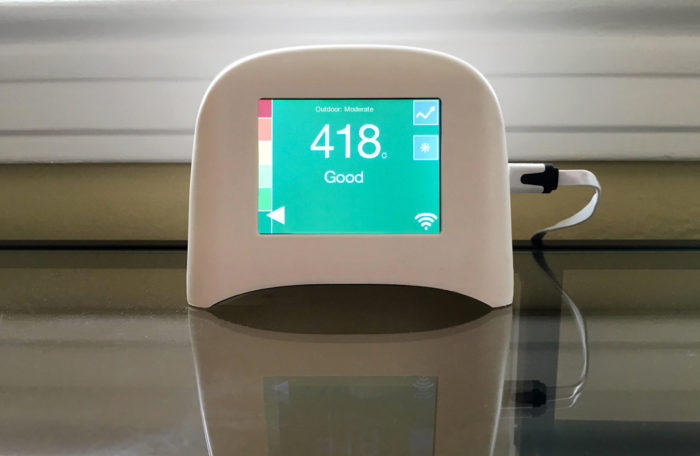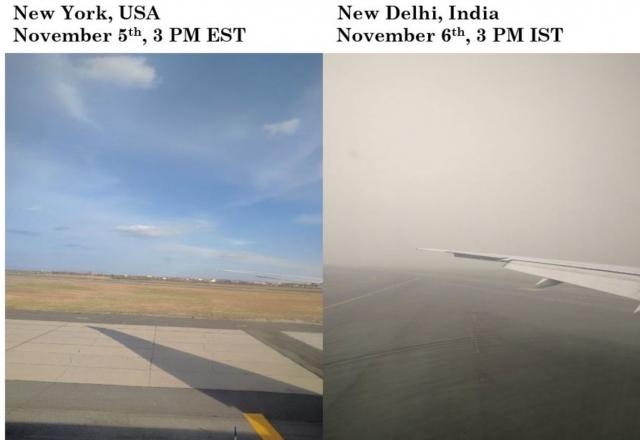
Image Credit: Speck
By RICHARD PELTIER
Until recently, measuring air pollution was a task that could be performed only by trained scientists using very sophisticated — and very expensive — equipment. That has changed with the rapid growth of small, inexpensive sensors that can be assembled by almost anyone. But an important question remains: Do these instruments measure what users think they are measuring?
A number of venture-capital-backed startup or crowd-funded groups are marketing sensors by configuring a few dollars’ worth of electronics and some intellectual property — mainly software — into aesthetically pleasing packages. The Air Quality Egg, the Tzoa and the Speck sensor are examples of gadgets that are growing in popularity for measuring air pollutants.
These devices make it possible for individuals without specialized training to monitor air quality. As an environmental health researcher, I’m happy to see that people are interested in clean air, especially because air pollution is closely linked with serious health effects. But there are important concerns about how well and how accurately these sensors work.
At their core, these devices rely on inexpensive, and often uncertain, measurement technologies. Someday small sensors costing less than $100 may replace much more expensive research-grade instruments like those used by government regulators. But that day is likely to be far away.
New territory for a known technology
Pollution sensors that measure air contaminants have been on the market for many years. Passenger cars have sophisticated emission controls that rely on data collected by air sensors inside the vehicles. These inexpensive sensors use well-established chemical and physical methods — typically, electrochemistry or metal oxide resistance — to measure air contaminants in highly polluted conditions, such as inside the exhaust pipe of a passenger vehicle. And this information is used by the vehicle to improve performance.
It turns out these sensors can work outside of your car, too. But they have some important limits. They are often not designed to work in the open air, where conditions are much cleaner than in vehicle exhaust. And they can be affected by conditions such as varying temperatures or relative humidity, or the presence of interfering gases that they are not designed to measure.
Sensor manufacturers sometimes provide limited information on these low-cost sensors, and it is very easy to use the devices improperly. This is because they are designed to work under very controlled conditions — for example, at fixed temperatures or with limited wind movement — and these requirements often are not communicated to consumers. Measurement accuracy is especially important when we are trying to understand how exposure to air pollutants can lead to health problems. If we rely on poor measurements and reach incorrect conclusions, we will fail to protect public health.
In a recent commentary in Nature, British researchers Alastair Lewis and Peter Edwards highlighted many questions about using inexpensive sensors to measure air pollution. They conclude that these technologies must be better validated prior to general public use, and warn that academic investigators should not be gatekeepers for using them. Rather, what we can do is provide essential test beds to evaluate sensor performance through testing and calibration. We also can call on sensor manufacturers to explain these devices’ limitations more clearly to customers.
Supporting citizen scientists
Many users of these sensor platforms are citizen scientists who have little formal training in measuring air quality. People are rightfully concerned about degraded air quality in their communities, and they are taking matters into their own hands by downloading open-source plans, purchasing a few items and deploying their measurement systems.
They can do this with the help of inexpensive, open-source microprocessors and a growing library of open-source software. Agencies such as the U.S. Environmental Protection Agency and the South Coast Air Quality Management District in California, among others, recognize this growing interest. They also see the potential danger of empowering anyone to build and use tools that can produce highly inaccurate information.
Miniaturized versions of expensive sensors still can cost thousands of dollars — far out of reach for most citizen scientists. So it is likely that market forces and consumer convenience are driving the growth of a do-it-yourself sensor market. Whatever the motivation, these sensors are being used now by many organizations, including concerned citizen advocacy groups, and to some extent by the regulatory community. Regulators are interested in these technologies because they can cheaply expand measurement capacity. But at the same time, they are cautious because of lingering uncertainties about measurements that do not comply with narrowly prescribed measurement methods.

It is not hard to build a $30 sensor to measure carbon monoxide, although such a device probably will not be able to measure concentrations less than, say, one part per million. In many wealthy countries, where pollution levels are relatively low, such a device would not produce meaningful measurements. But on a busy street in New Delhi, or near a brick kiln in Nepal, it could be quite useful because pollution levels are significantly higher.
Low-cost air monitoring does have merits. For much of the world, these tools could greatly increase understanding of pollution risks, especially in countries that do not have the financial resources or research infrastructure to produce sophisticated air quality measurements. Many environmental health scientists would like to expand the reach of these sensors to every corner of the world.
Use of DIY air sensors will continue to grow as people around the world learn more about the health risks of air pollution. The key is to make sure they work as reliably as possible. By expanding sound research measurements, we can continue to educate the public on the risks of air pollution, and to lobby for better protection from this hazard in a more informed way.
Richard Peltier is an associate professor of environmental health sciences at the University of Massachusetts, Amherst. This post originally appeared at The Conversation.
Weekly Newsletter
Get building science and energy efficiency advice, plus special offers, in your inbox.













5 Comments
So many permutations...
Great thoughts Richard
Some years ago we were building 28 new schools that required LEED IAQ certification. As the General Contractor we wanted to perform ongoing testing during construction (keeps contractors on their toes) but the consultant cost was, understandably, scary. So instead we spent the 10k on testing equipment, calibration gases and importantly, training.
What became immediately apparent was the incredible variation that seemingly small decisions could make on results. Height of sensor, proximity to doors, humidity etc. all played a huge role. The same applied when commissioning: even the best temperature probes were highly subject to location and operator consistency. The same issue was had with using CO2 sensors in HVAC systems: numbers were largely relative and it was the system operators experience that allowed refinement of set points.
So I am unsure how a consumer with a single point sensor and no knowledge will ever get 'usable' information beyond a numeric value. However what would intrigue me is a multipoint system, even if open source, that could be combined to give an overall 'picture' of conditions. Personally I'd love my HVAC to have the ability to ramp fresh air intake up and down dependant upon air quality......
The irony that transpired with the schools: indoor pollutants were FAR lower than outside due to the location in new subdivisions. Increasing 'fresh' air reduced air quality!!!!
Consumer products really are
Consumer products really are the part of the wild west, this is why regulations are required because snake oil makes for high profits.
Like many people I would be interested in accurate sensors but unless its certified and calibrated and a reliable technology its basically serendipity in a box
How do you know what's bad?
That's the first question that needs to be answered. Does LEED rule? WELL Building? ASHRAE? How many testing points? During what period of time? What a testing device tests (and its levels of "good" vs "bad" as well as instrument accuracy) need to be determined by an industry-wide rule. Just because you can go buy stuff doesn't mean you should. This level of scrutiny also applies to the mechanical ventilation side of the house too - just providing outside ventilation doesn't mean things are now "good" inside. And opening up windows whenever you "think" it is "good" thing to do may not be.
A bike is not a car
OK, this whole discussion has really been bugging me for a while now. These consumer IAQ monitors are like a bike. The pro ones are like cars. Both are transportation, but a bike is a poor substitute for a car. It's unfair to ask the 0-60 of a bike. Likewise, if we expect consumer grade IAQ monitors to be pro ones, we are fooling ourselves.
Here's how I look at it. Until these came out, I had no idea what was going on in client homes. Now I have some idea, a low/medium/high kind of thing. Semi-quantitative, which is what Foobot at least calls their device. I can see when I hit a home run. PM, RH and VOC levels plummet. Temperatures stabilize. I get instant feedback that my design worked. (Or didn't.)
These things are inexpensive enough that you can deploy multiple units in one home.
I have 30+ Foobots deployed, they have taught me a ton. Pressurizing a house during spray foam keeps VOC levels at or below levels in a closed up bedroom. (CO2 is sensed as a VOC with metal oxide sensors.) Leaving it closed up took 4 days for levels to fall to normal while a client was out of town. Another client used Foobots to play with his dampers and managed to get his second floor cooler than the first after a bunch of air sealing work. It used to be a 10-15 degree split.
For mold sensitive clienst, their VOCs had been all over the map. With pressurization and a dehumidifier VOC levels flatlined. I had feedback from the clients that the house was radically changed, but now I had graphs for it too.
These are going to be very useful for marketing and they're in my upcoming case studies. They are nearly instantaneous evidence that what we do actually works. Transparent accountability. Considering how little uptake there is of serious Home Performance upgrades, I'm delighted to have a tool that helps show that I can actually fix things while others merely say that they do.
Think of these things like FitBits. FitBits are off +/-20% on steps. 20%!! Yet when you aggregate enough of them together, you get a good idea of what's going on. Manufacturers can calibrate them against each other. They become useful because of big data.
These things are potentially VERY useful tools. Let's stop pooping all over them and trying to figure out their 0-60s. Let's figure out where they can be useful instead.
(Full disclosure, Foobot provided me with a number of donated units. They were my favorite of 7 reviewed IAQ monitors before this happened.)
Thanks Nate
If we don't know what level of a particular pollutant to target, having a poorly calibrated sensor is not really any worse than having a highly accurate sensor. The dangers of relying on them too much are real, but given that standard practice is one-size-fits-all ventilation rate that gets drastically revised every time it's considered by experts, and is met by only a small fraction of the existing housing stock, it's not very likely that these sensors will make the situation worse.
To balance Nate's bias towards Footbot in particular, I'll note that I don't like the Foobot's use of VOC as a proxy for CO2, but it's useful and there are others that have real, if not accurate, CO2 sensors.
Log in or create an account to post a comment.
Sign up Log in